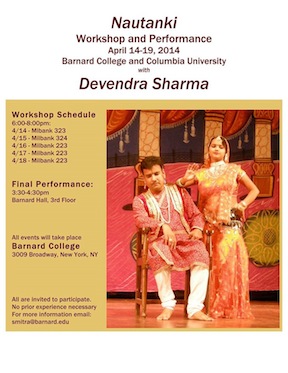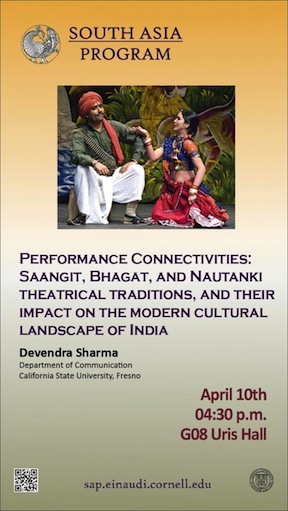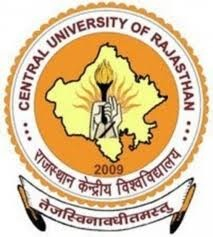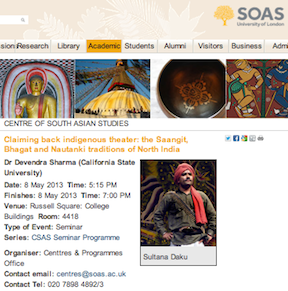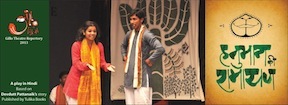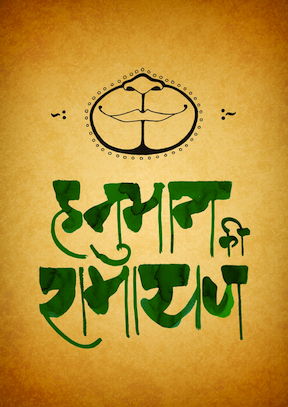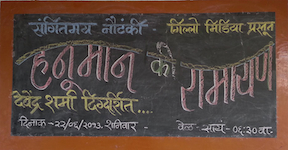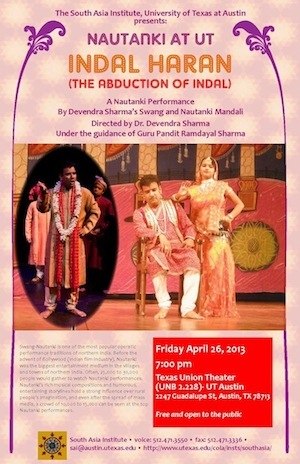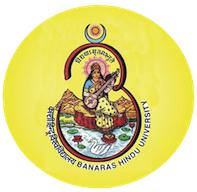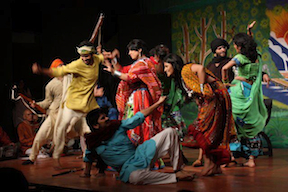References
Aden, R. C. (1999). Popular stories and promised lands: Fan cultures and symbolic pilgrimages. Tuscaloosa: University of Alabama Press.
Agrawal, G. S. (2000). Gyarah nukkad natak. Bijnaur, India: Hindi Sahitya Niketan.
Agrawal, R. (1976). Saangit, ek lok natya parampara. Delhi, India: Rajpal and Sons.
Awasthi, S. (1983). Drama: The gift of gods. Culture, performance and communication in India. In M. Yamaguchi (Ed.), Symbolism and world view in Asia and Africa. Tokyo: Institute for the Study of Languages and Cultures of Asia and Africa.
Bakhtin, M. M. (1984). Rabelais and his world. Bloomington. USA: Indiana University Press.
Barba, E. (2000). The deep order called turbulence: The three faces of dramaturgy.
TDR, 44:4. 56-66.
Basu, L. (2000). Taking it to the streets: The activist theater of Ngugi WaThiong’o and Safdar Hashmi [Electronic version]. Samar: South Asian Magazine for Action and Reflection, 13.
Becker, H. S., McCall, M. M., & Morris, L.V. (1989). Theater and communities: three scenes. Social Problems, 36, 93-116.
Bernstein, M. A. (1986). When the carnival turns bitter: Preliminary reflections upon the abject hero. In G. S. Morson (Ed.), Bakhtin: Essays and dialogues on his work. Chicago: The University of Chicago Press.
Berrong, R. M. (1968). Rabelais and Bakhtin: Popular culture in gargantua and pontagruel. Lincoln & London: University of Nebraska Press.
Boal, A. (1985). Theatre of the oppressed. New York: Theatre Communication Group.
Bordenave, J. D. (1976). Communication of agricultural innovations in Latin America: The need for new models. Communication research, 3(2),135-154.
Bourdieu, P. (1984). Distinction: A critique of the judgment of taste. Cambridge, MA: Harvard.
Brecht, B. (1964). A dialogue about acting. In J. Willet (Ed. & Trans.), Brecht on theatre. Hill & Wang.
Brij Lok Madhuri (2004). Entertainment for Better Health. SIFPSA, Lucknow, Uttar Pradesh, India. pp. 11-13.
Buber, M. (1994). Genuine dialogue and the possibility of peace. In R. Anderson, K. N. Cissna, & R. C. Arnett (Eds.), The reach of dialogue: Confirmation voice and community. Cresskill, NJ: Hampton Press.
Burke, K. (1969). A grammar of motives. University of California Press. Campbell, K. K. (1973). The rhetoric of women’s liberation: An oxymoron. Quarterly Journal of Speech, 59, 74-86.
Chawla, D., & Rawlins, W. K. (2004). Enabling reflexivity in a mentoring relationship. Qualitative Inquiry, 10, 963-978.
Cohen-Cruz, J. (2001). Motion of the ocean: The shifting face of U.S. theater for socialchange since the 1960s. Theater, 31 (3), 95-107.
Cohen, R. (1988). Realism. In M. Banham (Ed.), The Cambridge guide to theater (p. 815). Cambridge, UK: Cambridge University Press.
Conner, L. (1996). “What the modern dance should be”: Socialist agendas in the modern dance, 1931-38. In J. Reinelt (Ed.), Crucibles of crisis: Performing social change. Ann Arbor, Michigan: University of Michigan Press.
Conquergood, D. (1985). Performing as a moral act: Ethical dimensions of the ethnography of performance. Literature in Performance, 5, 1-13.
Conquergood, D. (1988). Health theatre in a Hmong refugee camp. Theater and Drama Review (TDR), 32, 174-207.
Conquergood, D. (1991). Rethinking ethnography: Towards a critical cultural politics. Communication Monographs, 58, 179-194.
Conquergood, D. (2002). Performance studies: Interventions and radical research. TDR. 46:2. 145-156.
Dahiya, P. (Ed.). (2002). Lok. Uadaipur, India: Bhartiya Lok Klala Mandal. Dagron, A. G. (2001). Making waves: Stories of participatory communication for social change. New York: The Rockefeller Foundation.
Danow, D. K. (1991). The thought of Mikhail Bakhtin: From word to culture. NewYork: St. Martin’s Press.
Denzin, N. K. (1997). Interpretive ethnography: Ethnographic practices for the 21st century. Thousand Oaks, CA: Sage.
Dion, G. (1996). From no man’s land to no man’s theater: The theater of the 8th day returns to capitalist Poland. In J. Reinelt (Ed.), Crucibles of crisis: Performing social change. Ann Arbor, Michigan: University of Michigan Press.
Downs, G. W. Jr., & Mohr, L. B. (1976). Conceptual issues in the study of innovations. Administrative Science Quarterly, 21, 700-714.
Elam, Jr. E. J. (1996). Social urgency, audience participation, and the performance of Slave Ship by Amiri Baraka. In J. Reinelt (Ed.), Crucibles of crisis: Performing social change. Ann Arbour, Michigan: The University of Michigan Press.
Ellis, C., & Bochner, A. P. (2000). Autoethnography, personal narrative, reflexivity: Researcher as subject In N. K. Denzin & Y. S. Lincoln (Eds.), Handbook of qualitative research. Thousand Oaks, CA: Sage.
English in India. Retrieved April 14, 2005, from http://www.indianchild.com/english_in_india.htm
Fine, E. C., & Speer, J. H. (Eds.). (1992). Performance, culture, and identity. Westport, Connecticut: Praeger.
Fisher, W. R. (1984). Narrative as a human communication paradigm. Communication Monograph, 51, 1-22.
Foss, S. K., & Griffin, C. L. (1995). Beyond persuasion: A proposal for an invitational rhetoric. Communication Monographs, 62, 2-18.
Freire, P. (1970). Pedagogy of the oppressed (M. B. Ramos, Trans.). New York: Herder and Herder.
Freire, P. (2004). The banking concept of education. In A. S. Canestrari & B. A. Marlowe (Eds.), Educational foundations: An anthology of critical readings. Thousand Oaks, California: Sage Publications.
Freire, P. (2005). Education for critical consciousness. London: Continuum.
Frey, L. R., Pearce, W. B., Pollock, M. A., Artz, L., & Murphy, B. A. O. (1996). Looking for justice in all the wrong places: On a communication approach to social justice. Communication Studies, 47, 110-127.
Friedman, M. (1993). What are friends for? Feminist perspectives on personal relationships and moral theory. Ithaca: Cornell University.
Gangal, A., & Hosterman, C. (1982). Toward an examination of the rhetoric of
ancient India. The Southern Speech Communication Journal, 47, 277-291.
Gargi, B. (1991). Folk theatre of India. Delhi, India: Rupa. Goffman, E. (1959). The presentation of self in everyday life. Garden City, N. Y.: Double Day.
Gonzalez, D. (2003). Young lives transformed, guided by a camera lens: Guatemalan fotokids capture pain and joy. New York Times, May 7, 2003. pp. 1 & 5.
Goodnight, T.G. (1982). The personal, technical, and public sphere of argumentation: A speculative inquiry into the art of public deliberation. Argumentation and Advocacy. 18. 214-227.
Hall, S. (1991). Encoding/Decoding. In M. G. Durham & D. Kellner (Eds.), Media and Cultural Studies: Keyworks. MA: Blackwell.
Hansen, K. (1992). Grounds for play: The Nautanki theatre of north India. Berkeley:University of California Press.
Harter, L. M., Sharma, D., Pant, S., Singhal, A., & Sharma, Y. (In Press). Catalyzing social reform through participatory performances in rural India. In L. Frey & K. Carragee (Eds.), Communication and social activism. Creskill, NJ: Hampton Press.
Havens, E. A. (1975). Diffusion of new seed varieties and its consequences: A Colombian case. In R.E. Dumett & L. J. Brainard (Eds.), Problems of rural development: Case studies and multidisciplinary perspective. Leiden, Netherlands: Brill.
Haynes, D. J. (1995). Bakhtin and the visual arts. Cambridge: Cambridge University Press.
Hirshkop, K. (1999). Mikhail Bakhtin: An aesthetic for democracy. New York: Oxford University Press.
Holquist, M., Liapunov, V. (Eds.). (1990). Art and answerability. Austin, Texas: University of Texas Press.
Hoy, M. (1994). Joyful mayhem: Bakhtin, football songs, and the carnivalesque. Text and Performance Quarterly, 14, 289-304.
Indian Institute of Mass Communication (1981). Communication and the traditional media: Papers and proceedings of seminar organized by I.I.M.C. and the Film and Television Institute of India, Pune. New Delhi, India: Indian Institute of Mass Communication.
Jackson, S. (1993). Ethnography and the audition: Performance as ideological critique. Text and Performance Quarterly, 13, 21-43.
Jackson, S. (1998). White noises: On performing white, on writing performance. Drama Review: A Journal of Performance Studies, 42(1), 90-97.
Jacobson, T. L. (2002). Participatory communication for social change: The relevance for the theory of communicative action. In P. J. Kalbfleisch (Ed.), Communication Yearbook (Vol. 27, pp. 87-123). Thousand Oaks, CA: Sage.
Jain, N. C. (1967). Rang darshan. Delhi, India: Akshar Prakashan.
Jones, J. (2002). Performance ethnography: The role of embodiment in cultural authenticity. Theater Topics.12:1: 1-15.
Joshi, L. D. (1967). Lok rangmanchiya kala. In D. Samar & M. Bhanavat (Eds.), Lok kala. Udaipur, India: Bhartiya Lok Kala Mandal.
Knowles, R. (Ed.). (1998). Shakespeare and carnival: After Bakhtin. New York:
MacMillan Press.
Kruger, A. C., & Tomasello, M. (1996). Cultural learning and learning culture. In D. Olson and N. Torrance (Eds.), The handbook of education and human development: New models of learning, teaching, and schooling. Cambridge, Mass: Blackwell.
Laing, R. D. (1994). Confirmation and disconfirmation. In R. Anderson, K. N. Cissna, & R. C. Arnett (Eds.), The reach of dialogue: Confirmation voice and community. Cresskill, NJ: Hampton Press.
Lamphere, L. (Ed.). (1992). Structuring diversity: ethnographic perspectives on the new immigration. Chicago: The University of Chicago Press.
Lerner, D. (1958). The passing of traditional society: Modernizing the Middle East. With the collaboration of Lucille W. Pevsner. New York : Free Press Lucaites, J. L., Condit, C.
M., & Caudill, S. (Eds.). (1999). Contemporary rhetorical theory. New York: Guilford Press.
Macovski, M. (Ed.). (1997). Dialogue and critical discourse. NewYork: Oxford
University Press.
Manuel, P. (1993). Cassette culture: Popular music and technology in north India. Chicago: University of Chicago Press.
McCall, J. E. (1993). The new negro. In C. Cullen (Ed.), Caroling dusk: An anthology of verse by black poets of the twenties. Secaucus, N.J.: Carol Publication Group.
Melkote, S. R., Steeves, L. H. (2001). Communication and development in the third world. New Delhi: Sage Publication.
Merton, T. (1994). Love and need: Is love a package or a message. In R. Anderson, K. N. Cissna, & R. C. Arnett (Eds.), The reach of dialogue: Confirmation voice and community. Cresskill, NJ: Hampton Press.
Mienczakowski, J., & Morgan, S. (2001). Ethnodrama: Constructing participatory, experiential and compelling action research through performance. In R. Reason & H. Bradbury (Eds.), Handbook of action research: Participative inquiry and practice (pp. 219-227). Thousand Oaks, CA: Sage.
Morris, N. (2003). A comparative analysis of the diffusion and participatory models in development communication. Communication Theory, 13, 225-248.
Morson, G. A. (1986). Dialogue, monologue, and the social: A reply to Ken Hirschkop. In G. S. Morson (Ed.), Bakhtin: Essays and dialogues on his work. Chicago: The University of Chicago Press.
O’Brien, A. (1994). Staging whiteness: Beckett, Havel, Maponya. Theater Journal, March 1994, 45- 62.
Okeley, J., & Callaway, H. (Eds.). (1992). Anthropology and autobiography. London: Routledge.
Paget, M. A. (1990). Performing the text. Journal of Contemporary Ethnography, 19, 136-155.
Peters, J. D. (1999). Speaking into the air: A history of the idea of communication. Chicago: The University of Chicago Press.
Pollock, D. (1990). Telling the told: Performing like a family. Oral History Review, 18, 1-36.
Prashad, V. (1999). Theatre of the people [Electronic version]. Himal: South Asian, January 1999.
Premchand, M. (1932). Godan. Delhi: Abhivyakti Prakashan.
Rangacharya, A. (1971). The Indian theatre. New Delhi, India: National Book Trust.
Rawlins, W. K. (1992). Friendship matters: Communication, dialects, and the life course. New York: Aldine de Gruyter.
Reinelt, J. (Ed.). (1996). Crucibles of crisis: Performing social change. Ann Arbor, Michigan: The University of Michigan Press.
Richardson, L. (1997). Fields of play: Constructing an academic life. New Brunswick, NJ: Rutgers University Press.
Rodriguez, N. M., & Villaverde, L. (2000). Dismantling white priviledge. New York: Peter Lang.
Rogers, E. M. (1962). Diffusion of innovations (1st ed.). Glencoe: Free Press.
Rogers, E. M. (1976). Communication and development: The passing of the dominant paradigm. Communication Research, 3, 121-148.
Rogers, E. M. (1986). Models of knowledge transfer: critical perspectives. In G. M. Beal, W. Dissanayake, & S. Konoshima (Eds.), Knowledge generation, exchange, and utilization (pp. 37-60). Boulder, Colrado: Westview.
Rogers, E. M. (1997). A History of communication study: A biographical approach. New York: Free Press. Rogers, E. M. (2003). Diffusion of innovations. (5th ed.). New York: Free Press.
Said, E. W. (1978). Orientalism. New York: Random House.
Sangeet Natak Akademi (1971). Proceedings of the round table on the contemporaryrelevance of traditional theatre. Sangeet Natak: Journal of the Sangeet Natak Akademi, 21, July- September 1971.
Sangeet Natak Akademi (1985). Traditional idiom in contemporary theatre. Special Issue of Sangeet Natak, Journal of Sangeet Natak Akademi, 77-78, July-December 1985.
Schechner, R. (1983). Performative circumstances: From the avant garde to ramlila. Calcutta, India: Seagull.
Schramm, W. L. (1964). Mass media and national development; the role of information in the developing countries. Stanford, California: Stanford University Press.
Schiappa, E. (1989). The rhetoric of nukespeak. Communication Monograph, 56, 253-271.
Schroeder, P. R. (1996). Transforming images of blackness: Dramatic representation, women playwrights, and the Harlem renaissance. In J. Reinelt (Ed.), Crucibles of crisis: Performing social change. Ann Arbor, Michigan: University of Michigan Press.
Schultz, E. A. (1990). Dialogue at the margins: Whorf, Bakhtin, and linguistic relativity. Madison, Wisconsin: The University of Wisconsin Press.
Sharma, D. (2004). Using folk performances to communicate health messages in rural India: A case study in rural India. Presented at the International Communication Association: New Orleans, 2004.
Shastri, R. (1987). Hariyana ka lok manch. Chandigarh, India: Hariyana Rajkiya Press.
Shefner-Rogers, C. L., Rao, N., Rogers, E. M., & Wayangankar, A. (1998). The empowerment of women dairy farmers in India. Journal of Applied Communication Research, 26:3, 319-337.
Shome, R. (1996). Postcolonial interventions in the rhetorical canon: An “other” view. Communication Theory, 6, 40-59.
Sieg, K. (1955). Subjectivity and socialism: Feminist discourses in East Germany. Genders, 22, 105-133.
Siegel, T., & Conquergood, D. (Producers & Directors). (1985). Between two worlds: The Hmong shaman in America [Video Documentary].
Siegel, T., & Conquergood, D. (Producers & Directors). (1990). The heart broken in half [Video Documentary].
SIFPSA. (2003). Communication channels. Lucknow: SIFPSA.
Simons, H. W., & Billig, M. (Eds.). (1994). After postmodernism: Reconstructing ideology critique. London: Sage.
Singhal, A. (2004). Entertainment education through participatory theater: Freirean strategies for empowering the oppressed. In A. Singhal, M. Cody, E. M. Rogers, & M. Sabido (Eds.), Entertainment-education and social change: History, research, and practice (pp. 377-398). Mahwah, NJ: Lawrence Erlbaum.
Singhal, A., & Howard, W. S. (Eds.). (2003). The children of Africa confront AIDS: From vulnerability to possibility. Athens, OH: Ohio University Press.
Singhal, A., & Rattine-Flaherty, E. (2006). Pencils and photos as tools of communicative research and praxis. In The International Communication Gazette, 68:4, 313- 330.
Singhal, A., Rogers, E. M. (2003). Combating AIDS: Communication strategies in action. New Delhi: Sage Publications.
Singhal, A., Sharma, D., Papa, M.J., & Witte, K. (2004). Air cover and ground mobilization: Integrating entertainment-education broadcasts with community listening and service delivery in India. In A. Singhal, M. Cody, E.M. Rogers, and M. Sabido (Ed), Entertainment-Education and social change: History, research, and practice. Mahwah, NJ: Lawrence Erlbaum Associates.
Smith, A. D. (1993). Fires in the mirror: Crown Heights, Brooklyn, and other identities. Garden City, NY: Anchor.
Smith, A.D. (1994). Twilight: Los Angeles, 1992. Garden City, NY: Anchor.
Taylor, D. (1990). Theater and terrorism: Griselda Gambaro’s information for
foreigners. Theater Journal, May 1990, 165- 182.
Tedlock, B. (1991). From participant observation to the observation of participation: The emergence of narrative ethnography. Journal of Anthropological Research, 47, 69-94.
Tedlock, B. (2000). Ethnography and ethnographic representation. In N. K. Denzin & Y. S. Lincoln (Eds.), Handbook of qualitative research. Thousand Oaks: Sage.
Thapar, R. (1966). A history of India. Harmondsworth: Penguin Books.
Todorov, T. (1984). Mikhail Bakhtin: The dialogical principle. W. Godzich (Trans.). Minneapolis, Minnesota: University of Minnesota Press.
Trotter, M. (1996). Women’s work: Inghinidhe na hEireann and the Irish democratic movement. In J. Reinelt (Ed.), Crucibles of crisis: Performing social change. Ann Arbour, Michigan: The University of Michigan Press.
Turner, V. M., Bruner, E. M. (Eds.). (1986). The anthropology of experience. Urbana: University of Illinois Press.
Varadpande, M.L. (1992). History of Indian theatre: Lokranga, panorama of Indian theatre. New Delhi, India: Abhinav Publications.
Vatsyayan, K. (1971). Aesthetic theories underlying Asian performing arts. In J. R. Brandon (Ed.), The performing arts in Asia. Paris: UNESCO.
Vatsyayan, K. (1995). Traditional Indian theatre: Multiple streams. New Delhi, India: National Book Trust.
Versenyi, A. (1996). The Mexican revolution: Religion, politics, and theater. In J. Reinelt (Ed.), Crucibles of crisis: Performing social change. Ann Arbor, Michigan: The University of Michigan Press.
Wadley S. S. (2001). Popular culture and the north Indian oral epic Dhola. Indian Folklore Research Journal, 1(1), 13-24.
Wander, P. (1984). The third persona: An ideological turn in rhetorical theory. Communication Studies, 35, 197-216.
Wesling, D. (2003). Bakhtin and the social moorings of poetry. London: Associated University Presses.
Williams, R. (1958). Culture is ordinary. In N. Mackenzie (Ed.), Conviction. London: McGibbon and Kee.
Williams, R. (1967). Literature and Rural Society. The Listener, 78. Williams, R. (1976). Key words. New York: Oxford University Press.
Williams, R. (2000). Cultural production and the labor process. In V. N. Paananen (Ed.), British Marxist criticism (pp. 189-196). New York: Garland Pub.
Wills, C. (2001). Upsetting the public: Carnival, hysteria, and women’s texts. In K. Hirschkop, D. Shepherd (Eds.), Bakhtin and cultural theory. Manchester:
Manchester University Press.
Wolff, K. H. (1964). Surrender and community Study: The study of Loma. In A. J. Vidich, J. Bensman, & M. R. Stein (Eds.), Reflections on community studies (pp. 233-263). New York: John Wiley.
Worthen, W. B. (1996). Convicted reading: The island, hybridity, performance. In J. Reinelt (Ed.), Crucibles of crisis: Performing social change. Ann Arbor, Michigan: University of Michigan Press.

